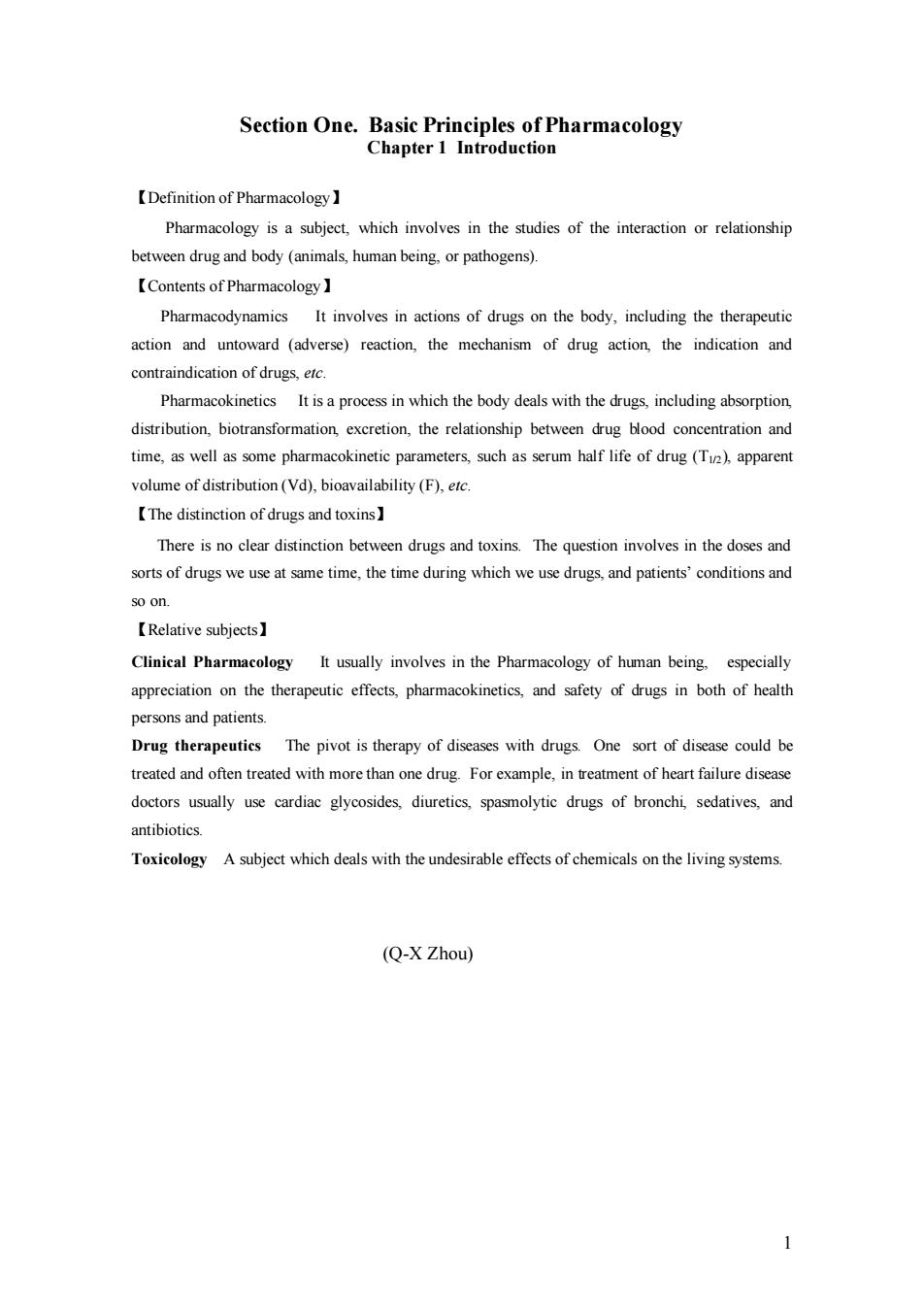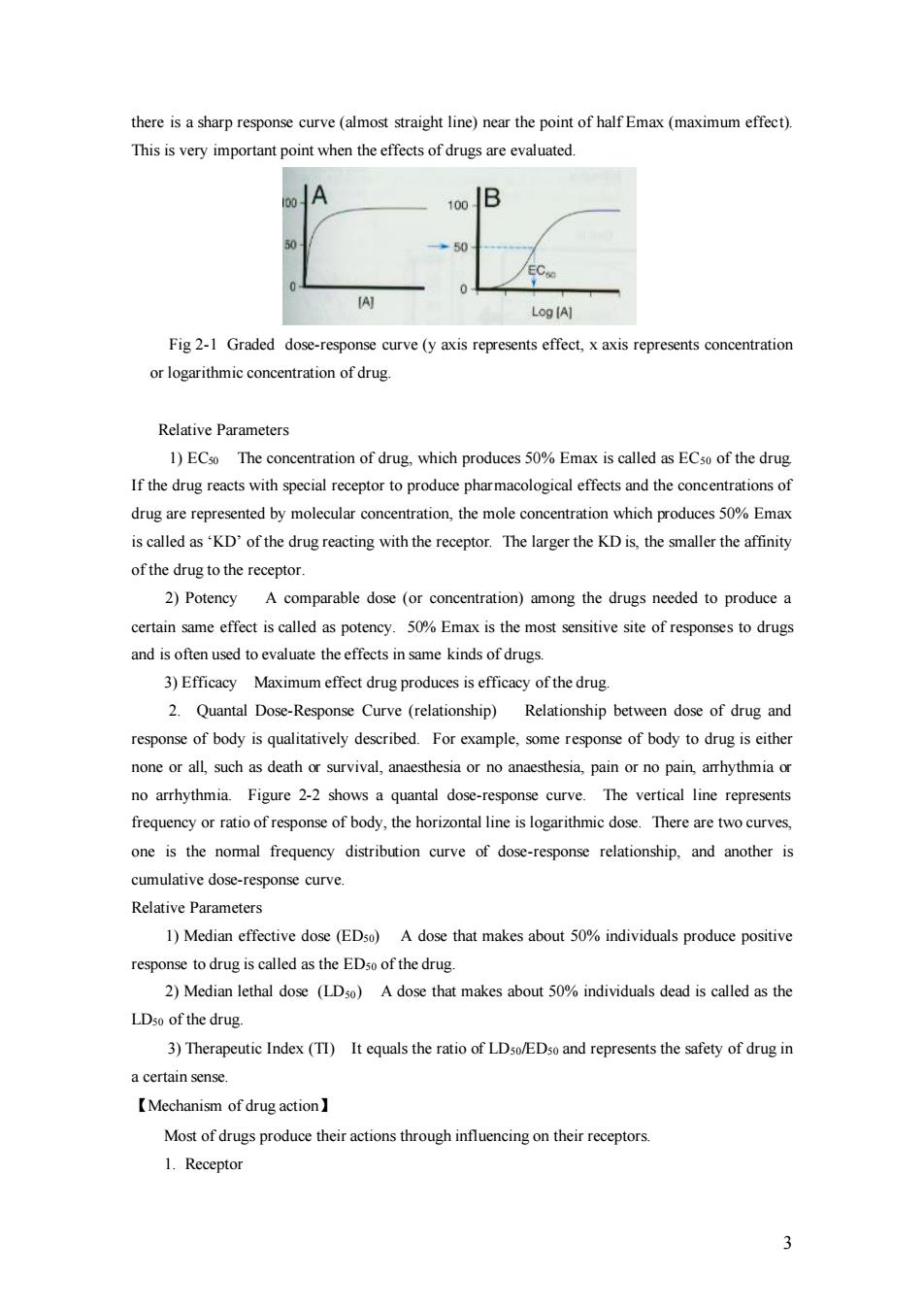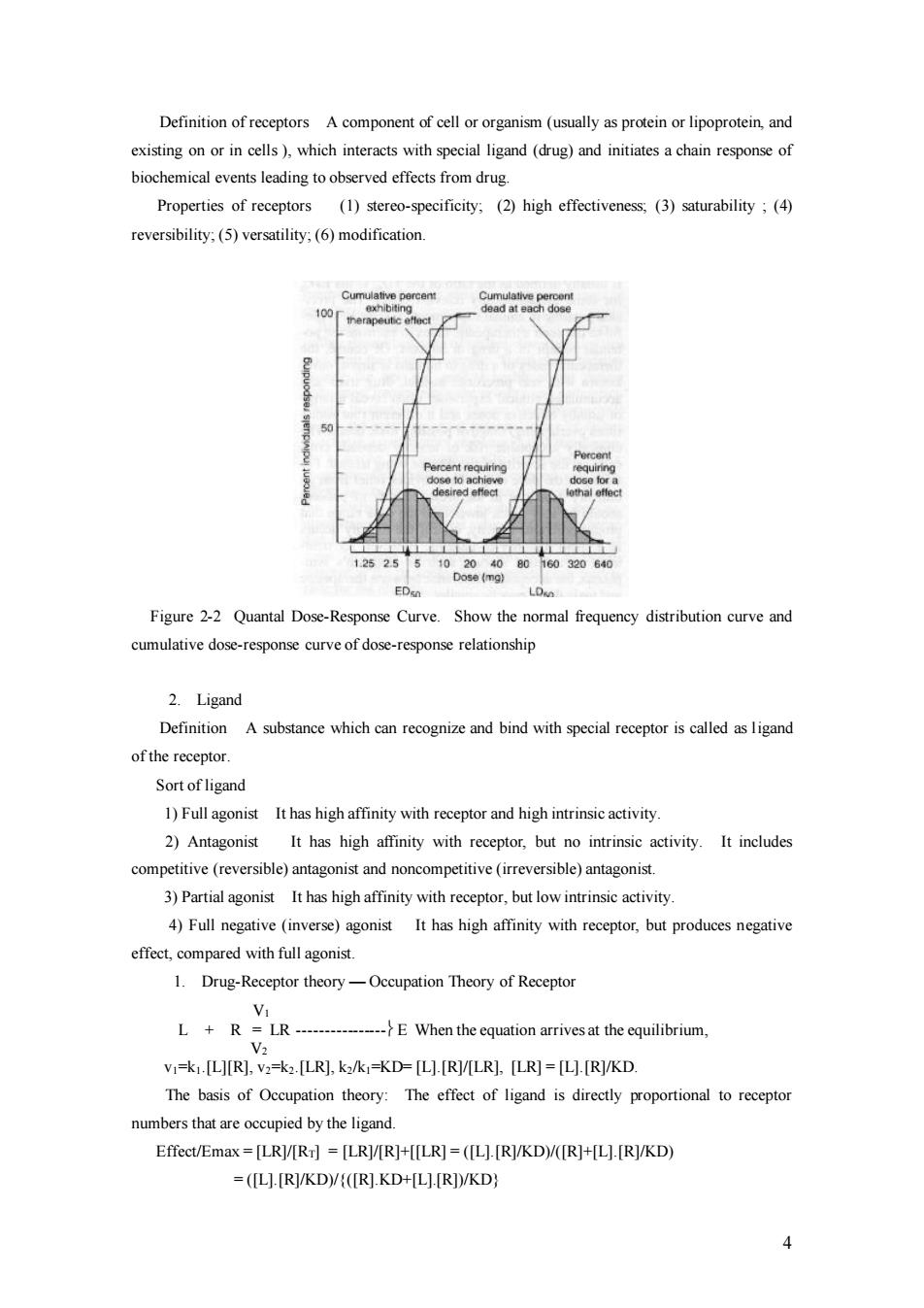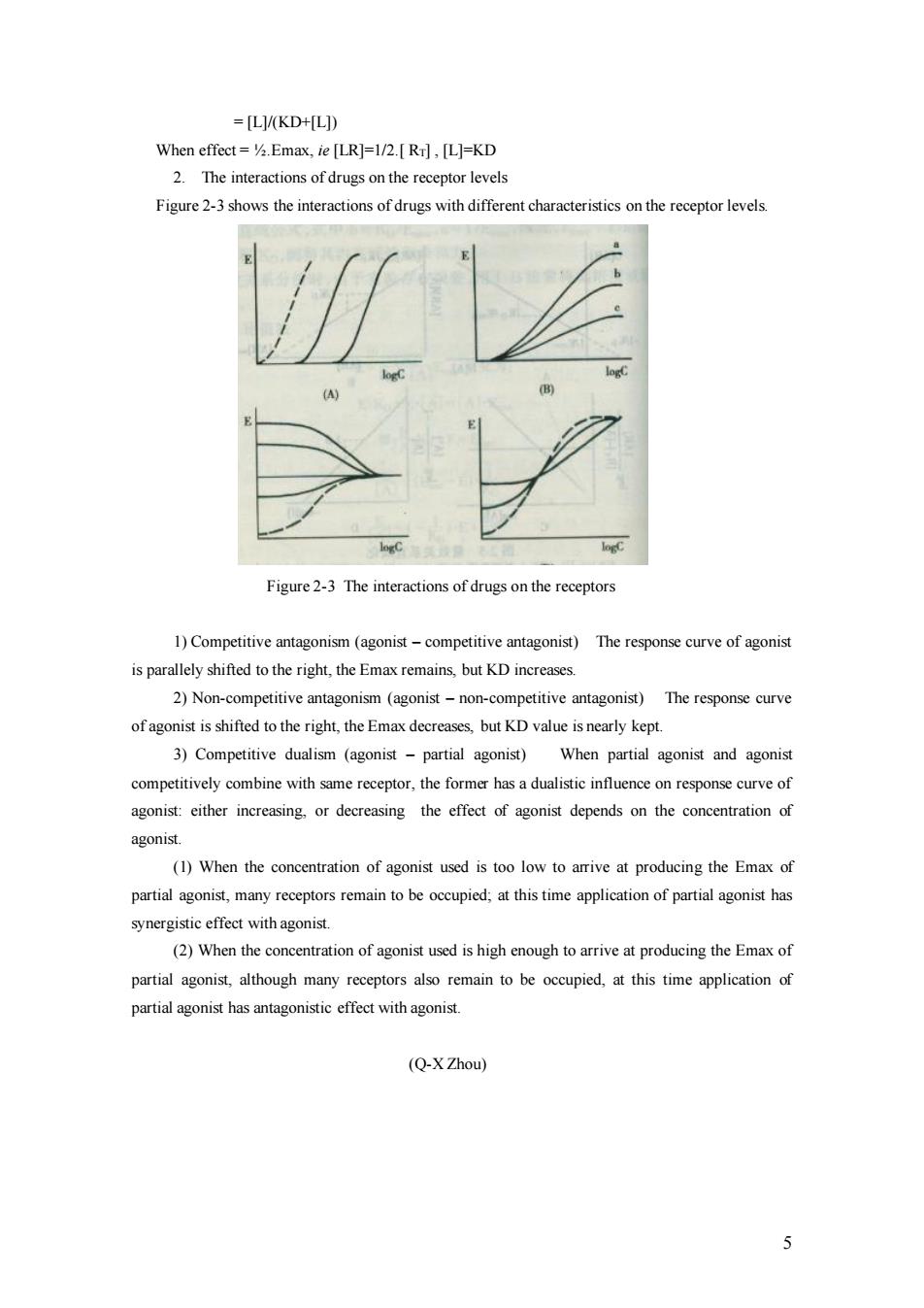
Section One.Basic Principles of Pharmacology Chapter 1 Introduction 【Definition of Pharmacology】 Pharmacology is a subject,which involves in the studies of the interaction or relationship between drug and body (animals,human being.or pathogens). 【Contents of Pharmacology】 Pharmacodynamics It involves in actions of drugs on the body,including the therapeutic action and untoward (adverse)reaction,the mechanism of drug action,the indication and corndiio ofrugs Pharmacokinetics It is a process in which the body deals with the drugs,including absorption, distribution.biotransformationexcretion the relationship betweenrug blood concentration and time,as well as some pharmacokinetic parameters,such as serum half life of drug (T),apparent volume of distribution(Vd),bioavailability (F), 【The distinction of drugs and toxins】 There is no clear distinction between drugs and toxins.The question involves in the doses and sorts of drugs we use at same time,the time during which we use drugs,and patients'conditions and so on. 【Relative subjects】 Clinical Pharmacology It usually involves in the Pharmacology of human being.especially appreciation on the therapeutic effects,pharmacokinetics,and safety of drugs in both of health persons and patients Drug therapeutics The pivot is therapy of diseases with drugs.One sort of disease could be treated and often treated with more than one drug For example,in reatment of heart failure disease doctors usuallyuse cardiac glycosides,diuretics.spasmolytic drugs of bronchi,sedatives,and antibiotics. A subject which deals with the undesirable effects of chemicals on the living systems (Q-X Zhou)
1 Section One. Basic Principles of Pharmacology Chapter 1 Introduction 【Definition of Pharmacology】 Pharmacology is a subject, which involves in the studies of the interaction or relationship between drug and body (animals, human being, or pathogens). 【Contents of Pharmacology】 Pharmacodynamics It involves in actions of drugs on the body, including the therapeutic action and untoward (adverse) reaction, the mechanism of drug action, the indication and contraindication of drugs, etc. Pharmacokinetics It is a process in which the body deals with the drugs, including absorption, distribution, biotransformation, excretion, the relationship between drug blood concentration and time, as well as some pharmacokinetic parameters, such as serum half life of drug (T1/2), apparent volume of distribution (Vd), bioavailability (F), etc. 【The distinction of drugs and toxins】 There is no clear distinction between drugs and toxins. The question involves in the doses and sorts of drugs we use at same time, the time during which we use drugs, and patients’ conditions and so on. 【Relative subjects】 Clinical Pharmacology It usually involves in the Pharmacology of human being, especially appreciation on the therapeutic effects, pharmacokinetics, and safety of drugs in both of health persons and patients. Drug therapeutics The pivot is therapy of diseases with drugs. One sort of disease could be treated and often treated with more than one drug. For example, in treatment of heart failure disease doctors usually use cardiac glycosides, diuretics, spasmolytic drugs of bronchi, sedatives, and antibiotics. Toxicology A subject which deals with the undesirable effects of chemicals on the living systems. (Q-X Zhou)

Chapter 2 Pharmacodynamics 【General characteristics of drug effects】? The drugs only influence on the intrinsic functions of body from two aspects of either excitation (stimulation)inhibtion(suppresion).For example the heart rate,blod pressure, and level of serum sugar-excitation:on the contrary,-inhibition. 【Selectivity of drug effects】? doses,and administrative routes of drugs.The high selectivity of drug effects means that the drug has a narrow action on the target organs,the low selectivity means that the drug has a much wide action on the body. 【Consequences of drug actions】 1.Therapeutic effect The effect which is relative with the purpose of treatment and brings the patient benefit.It includes etiological treatment and symptomatic treatment. 2 Untoward reaction(adverse reaction)It is reaction of drug.which isnot relative with the purpose of treatment,but also causes the patients much troubles. 【The sorts reactions】 1.Side reaction It is a pharmacological action which is not related with therapeutic purpose of drug.when the drug is given with ordinary dose.For example:atropine,ephedrine. 2.Toxic reaction It is much serious phenomenon usually caused by either overloading dose of drug.or chronic administration of drugs. There exist specific toxicities about drugs in particular population,such as teratogenesis carcinogenesis,and mutagenesis. 3.After effect (reaction)It is a residual effect of drug when the level of drug is reduced below the threshold concentration.For example,sleeping drug. 4.Allergic reaction Aidiosyncratic eaction taking place inthe minority patients without any relationships to pharmacological effect and dose of drug. 5.Dependence of drug change of the body condition,which makes the patients produce physiological or pychological dependence on the drug afer taking the drug repeatedy.and abstinence syndrome may be induced if the patients stop taking the medicine suddenly. It is usually represented by a responsive curve with the vertical line as effect of drug and horizontal ne(). 1.Graded dose-response relation The relationship between the dose(concentration)of drug and effect(response)of the preparation is quantitatively described.Figure 2-1 shows a graded concentration-effect curve about noradrenaline on the aorta of rabbit When arithmetical progression is used to represent concentration the response of aorta to drug exhibits a 'long tail S'shape. However,when logarithmic concentration is used it is given symmetryS'shape.From figure 2-1 2
2 Chapter 2 Pharmacodynamics 【General characteristics of drug effects】 The drugs only influence on the intrinsic functions of body from two aspects of either excitation (stimulation) or inhibition (suppression). For example, promotion of the heart rate, blood pressure, and level of serum sugar — excitation; on the contrary, — inhibition. 【Selectivity of drug effects】 The selectivity of drug effects is comparable, or relative; it depends on the properties of drugs, doses, and administrative routes of drugs. The high selectivity of drug effects means that the drug has a narrow action on the target organs; the low selectivity means that the drug has a much wide action on the body. 【Consequences of drug actions】 1. Therapeutic effect The effect which is relative with the purpose of treatment and brings the patient benefit. It includes etiological treatment and symptomatic treatment. 2. Untoward reaction (adverse reaction) It is reaction of drug, which is not relative with the purpose of treatment, but also causes the patients much troubles. 【The sorts of adverse reactions】 1. Side reaction It is a pharmacological action which is not related with therapeutic purpose of drug, when the drug is given with ordinary dose. For example: atropine, ephedrine. 2. Toxic reaction It is much serious phenomenon usually caused by either overloading dose of drug, or chronic administration of drugs. There exist specific toxicities about drugs in particular population, such as teratogenesis, carcinogenesis, and mutagenesis. 3. After effect (reaction) It is a residual effect of drug, when the level of drug is reduced below the threshold concentration. For example, sleeping drug. 4. Allergic reaction A idiosyncratic reaction taking place in the minority patients without any relationships to pharmacological effect and dose of drug. 5. Dependence of drug A change of the body condition, which makes the patients produce physiological or psychological dependence on the drug after taking the drug repeatedly, and abstinence syndrome may be induced if the patients stop taking the medicine suddenly. 【Dose-effect relationship】 It is usually represented by a responsive curve with the vertical line as effect of drug and horizontal line as dose (concentration). 1. Graded dose-response relation The relationship between the dose (concentration) of drug and effect (response) of the preparation is quantitatively described. Figure 2-1 shows a graded concentration-effect curve about noradrenaline on the aorta of rabbit. When arithmetical progression is used to represent concentration the response of aorta to drug exhibits a ‘long tail S’ shape. However, when logarithmic concentration is used it is given symmetry ‘S’ shape. From figure 2-1

there is a sharp response curve (almost straight line)near the point of half Emax(maximum effect). This is very important point when the effects of drugsare evaluated. 50 LogI闪 Fig2-1 Graded dose-response curve(y axis represents effect,x axis represents concentration or logarithmic concentration of drug Relative Parameters 1)ECso The concentration of drug.which produces 50%Emax is called as ECso of the drug If the drug reacts with special receptor to produce pharmacological effects and the concentrations drug are represented by molecular concentration.the mole concentration which produces 50%Emax is called asKDof the drug reacting with the receptor.The larger the KDis,the smaller the affinity of the drug to the receptor. 2)Potency A comparable dose (or concentration)among the drugs needed to produce a certain same effect is called as potency.%Emax is the most sensitive site of responses to drugs and is often used to evaluate the effects in same kinds of drugs. 3)Efficacy Maximum effect drug produces is efficacy of the drug 2.Quantal Dose-Response Curve (relationship)Relationship between dose of drug and respons of body is qualitatively described.For of body to drug is either none or all,such as death or survival,anaesthesia or no anaesthesia,pain or no pain,amhythmiaor no arrhythmia.Figure 2-2 shows a quantal dose-response curve.The vertical line represents frequency or ratio of response of body,the horizontal line is logarithmic dose.There are two curves, one is the nommal frequency distribution curve of dose-response relationship.and another is cumulative dose-response curve Relative Parameters 1)Median effective dose(EDso)A dose that makes about 0%individuals produce positive response to drug is called as the EDso of the drug. 2)Median lethal dose (LDso)A dose that makes about 50%individuals dead is called as the LDso of the drug 3)Therapeutic Index (T)It equals the ratio of LD/EDs and represents the safety of drug in a certain sense. 【Mechanism of drug action】 Most of drugs produce their actions through influencing on their receptors 1.Receptor
3 there is a sharp response curve (almost straight line) near the point of half Emax (maximum effect). This is very important point when the effects of drugs are evaluated. Fig 2-1 Graded dose-response curve (y axis represents effect, x axis represents concentration or logarithmic concentration of drug. Relative Parameters 1) EC50 The concentration of drug, which produces 50% Emax is called as EC50 of the drug. If the drug reacts with special receptor to produce pharmacological effects and the concentrations of drug are represented by molecular concentration, the mole concentration which produces 50% Emax is called as ‘KD’ of the drug reacting with the receptor. The larger the KD is, the smaller the affinity of the drug to the receptor. 2) Potency A comparable dose (or concentration) among the drugs needed to produce a certain same effect is called as potency. 50% Emax is the most sensitive site of responses to drugs and is often used to evaluate the effects in same kinds of drugs. 3) Efficacy Maximum effect drug produces is efficacy of the drug. 2. Quantal Dose-Response Curve (relationship) Relationship between dose of drug and response of body is qualitatively described. For example, some response of body to drug is either none or all, such as death or survival, anaesthesia or no anaesthesia, pain or no pain, arrhythmia or no arrhythmia. Figure 2-2 shows a quantal dose-response curve. The vertical line represents frequency or ratio of response of body, the horizontal line is logarithmic dose. There are two curves, one is the normal frequency distribution curve of dose-response relationship, and another is cumulative dose-response curve. Relative Parameters 1) Median effective dose (ED50) A dose that makes about 50% individuals produce positive response to drug is called as the ED50 of the drug. 2) Median lethal dose (LD50) A dose that makes about 50% individuals dead is called as the LD50 of the drug. 3) Therapeutic Index (TI) It equals the ratio of LD50/ED50 and represents the safety of drug in a certain sense. 【Mechanism of drug action】 Most of drugs produce their actions through influencing on their receptors. 1. Receptor

Definition of receptors A component of cell or organism(usually as protein or lipoprotein,and existing onor),which interacts with special ligand (drug)and initiates a chain response of biochemical events leading to observed effects from drug. Properties of receptors (1)stereo-specificity.(2)high effectiveness.(3)saturability:(4) reversibility:(5)versatilitv:(6)modification. 12s250,09 80 032064 ED. Figure 2-2 Quantal Dose-Response Curve.Show the normal frequency distribution curve and cumulative dose-response curve of dose-response relationship 2.Ligand Definition A substance which can recognize and bind with special receptor is called as ligand ofthe receptor. Sort of ligand 1)Full agonist It has high affinity with receptor and high intrinsic activity 2)Antagonist It has high affinity with receptor,but no intrinsic activity.It includes competitive (reversible)antagonist and noncompetitive(irreversible)antagonist. 3)Partial agonist It has high affinity with receptor,but low intrinsic activity. 4)Full negative(inverse)agonist It has high affinity with receptor,but produces negative effect.compared with full agonist. 1.Drug-Receptor theory-Occupation Theory of Receptor L+R LR- -E When the equation arrives at the equilibrium, v=k1.[L][R].vz=k2.[LR].kz/ky=KD=[L].[Rl/[LR].[LR]=[L].[R]/KD. The basis of Occupation theory:The effect of ligand is directly proportional to receptor numbers that are occupied by the ligand. Effect/Emax=[LRVIR]=[LR]/IR]+[[LR]=([L].[R]/KD)/([R]+[L].[R]/KD) =([L][R]/KD)/(([R].KD+[L][R]/KD)
4 Definition of receptors A component of cell or organism (usually as protein or lipoprotein, and existing on or in cells ), which interacts with special ligand (drug) and initiates a chain response of biochemical events leading to observed effects from drug. Properties of receptors (1) stereo-specificity; (2) high effectiveness; (3) saturability ; (4) reversibility; (5) versatility; (6) modification. Figure 2-2 Quantal Dose-Response Curve. Show the normal frequency distribution curve and cumulative dose-response curve of dose-response relationship 2. Ligand Definition A substance which can recognize and bind with special receptor is called as ligand of the receptor. Sort of ligand 1) Full agonist It has high affinity with receptor and high intrinsic activity. 2) Antagonist It has high affinity with receptor, but no intrinsic activity. It includes competitive (reversible) antagonist and noncompetitive (irreversible) antagonist. 3) Partial agonist It has high affinity with receptor, but low intrinsic activity. 4) Full negative (inverse) agonist It has high affinity with receptor, but produces negative effect, compared with full agonist. 1. Drug-Receptor theory — Occupation Theory of Receptor V1 L + R = LR - E When the equation arrives at the equilibrium, V2 v1=k1.[L][R], v2=k2.[LR], k2/k1=KD= [L].[R]/[LR], [LR] = [L].[R]/KD. The basis of Occupation theory: The effect of ligand is directly proportional to receptor numbers that are occupied by the ligand. Effect/Emax = [LR]/[RT] = [LR]/[R]+[[LR] = ([L].[R]/KD)/([R]+[L].[R]/KD) = ([L].[R]/KD)/{([R].KD+[L].[R])/KD}

=IL(KD+ILI) When effect=/.Emax.ie[LR]=1/2.[R].[L]=KD 2.The interactions of drugs on the receptor levels Figure2-3 shows the interactions of drugs with different characteristics on the receptor levels Figure2-3 The interactions of drugs on the receptors 1)Competitive antagonism(agonist-competitive antagonist)The response curve of agonist is parallely shifted to the right,the Emax remains,but KD increases. 2)Non-competitive antagonism (agonist-non-competitive antagonist)The response curve of agonist is shifted to the right,the Emax decreases but KD value is nearly kept 3)Competitive dualism (agonist-partial agonist)When partial agonist and agonist competitively combine with same receptor,the former has a dualistic influence on response curve of agonist:either increasing,or decreasing the effect of agonist depends on the concentration of (1)When the concentration of agonist used is too low to arrive at producing the Emax of partial agonist,many receptors remain to be occupied:at this time application of partial agonist has synergistic effect with agonist. (2)When the concentration of agonist used is high enough toarrive at producing the Emax of partial agonist,although many receptors also remain to be occupied,at this time application of partial agonist has antagonistic effect with agonist. (Q-X Zhou)
5 = [L]/(KD+[L]) When effect = ½.Emax, ie [LR]=1/2.[ RT] , [L]=KD 2. The interactions of drugs on the receptor levels Figure 2-3 shows the interactions of drugs with different characteristics on the receptor levels. Figure 2-3 The interactions of drugs on the receptors 1) Competitive antagonism (agonist – competitive antagonist) The response curve of agonist is parallely shifted to the right, the Emax remains, but KD increases. 2) Non-competitive antagonism (agonist – non-competitive antagonist) The response curve of agonist is shifted to the right, the Emax decreases, but KD value is nearly kept. 3) Competitive dualism (agonist – partial agonist) When partial agonist and agonist competitively combine with same receptor, the former has a dualistic influence on response curve of agonist: either increasing, or decreasing the effect of agonist depends on the concentration of agonist. (1) When the concentration of agonist used is too low to arrive at producing the Emax of partial agonist, many receptors remain to be occupied; at this time application of partial agonist has synergistic effect with agonist. (2) When the concentration of agonist used is high enough to arrive at producing the Emax of partial agonist, although many receptors also remain to be occupied, at this time application of partial agonist has antagonistic effect with agonist. (Q-X Zhou)